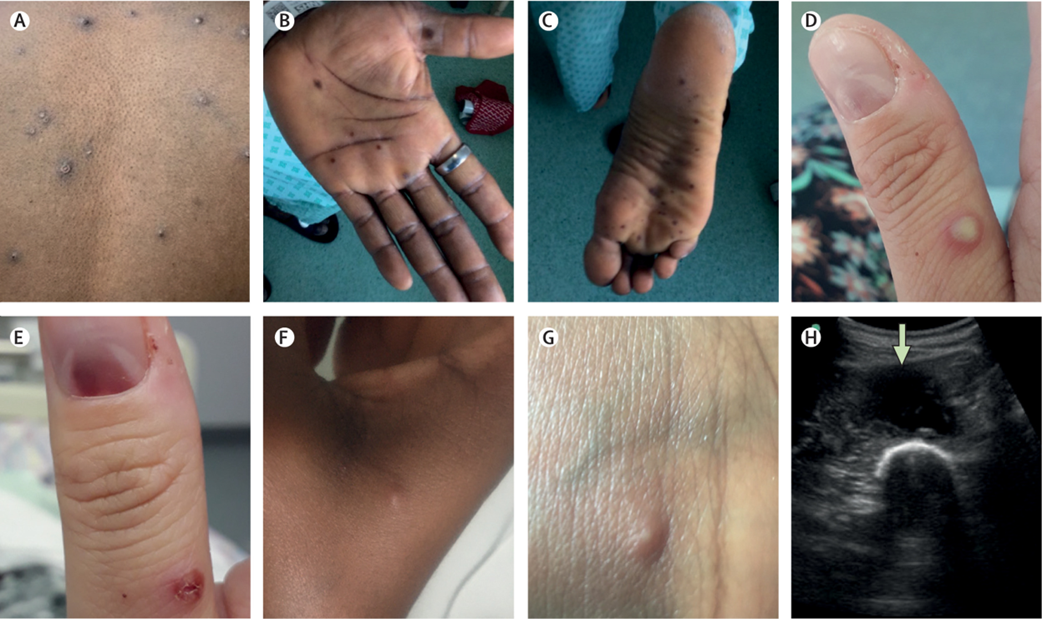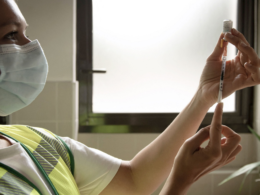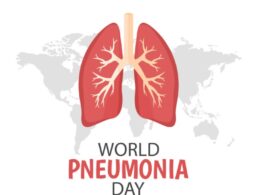The Lancet, Regional Health, Americas
Alfonso J. Rodriguez-Morales,a,b,c * Gustavo Lopardo,d Sergio Verbanaz,e Tomas Orduna,d,f Susana Lloveras,d,f Jose María Azenas-Burgoa, ~ g Juan Pablo Escalera-Antezana,h Lucia Elena Alvarado-Arnez,i Alexandre Naime Barbosa,h, Fredi Diaz-Quijano,k et all,
July 06, 2022
Key messages summarized by:
Joaquim Cardoso MSc
Health Transformation Institute
Pandemics Response Unit
July 10, 2022
- Despite its still moderate risk for expansion, allocation of necessary resources, strengthening epidemiological surveillance systems, and increased capacity building should be promptly prioritized in Latin American countries …
- … to detect imported cases and limit onward transmission (including autochthonous cases), which is expected to occur after the arrival imported cases.
- One of the great challenges and lessons learned from the pandemic relates to failures in risk communication.
- In this sense, strengthening epidemiological surveillance systems, and disseminating adequate information through reliable channels (official social media and web pages) with clear and assertive messages could contribute to gaining greater confidence from the broad public and assisting in the early case detection, thus halting transmission chains and preventing further outbreaks.
- Latin America, fortunately, is now more prepared to confront new epidemic threats, as in the case of MPX
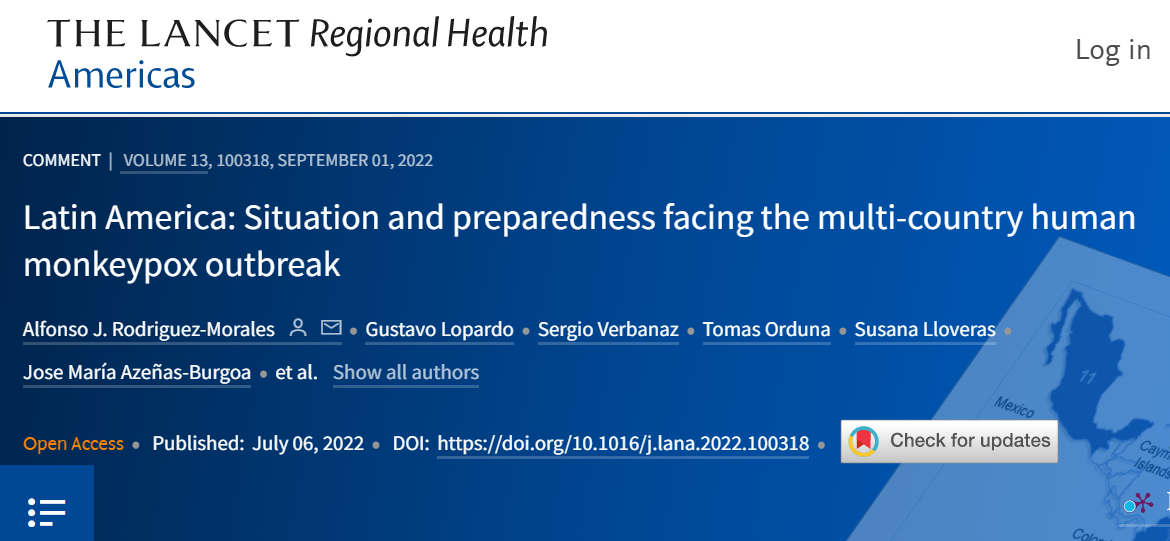
Still without ceasing the Coronavirus Disease 2019 (COVID-19) pandemic, a new viral threat has now emerged outside its endemic niche in Africa affecting multiple countries and continents.
After its appearance in May 2022, a multi-country outbreak of monkeypox disease (MPX) has triggered significant concerns due to its rapid spread and potential for sexual transmission (as suggested by the detection of viral DNA in sexual fluids); this, in addition to the previously known transmission routes described throughout endemic countries of Africa over the last decades or the imported or travel-related cases reported since 2003. 1
By June 28, 2022, at least 48 cases in seven Latin American countries (Argentina, Brazil, Chile, Colombia, Mexico, Peru, and Venezuela) have been PCR-confirmed, with at least 16 additional suspected cases (Figure 1). 2
Most countries in the region have settled their epidemiological surveillance to detect probable and suspected cases according to national and international case definitions (by the World Health Organization).
In addition, the Pan-American Health Organization has issued an epidemiological alert (https://bit.ly/3MUwYNI), with a series of considerations addressing the identification of cases, isolation, follow-up, contact tracing, clinical management, prevention and control.
Nevertheless, multiple concerns have been raised, mainly from the healthcare sector, regarding currently available treatments and vaccination.
Despite the absence of specific therapeutic alternatives for MPX, drugs with proven experimental efficacy and potential clinical impact such as cidofovir (especially its lipid conjugate brincidofovir) and tecovirimat, are not widely available in the region.
Also, although MPX vaccination has been implemented for contacts of positive cases, at this stage, neither non-replicating/replicating-deficient live vaccinia virus-based vaccines with low reactogenicity, such as JYNNEOS®, nor classical anti-smallpox vaccines are available in most Latin American countries.
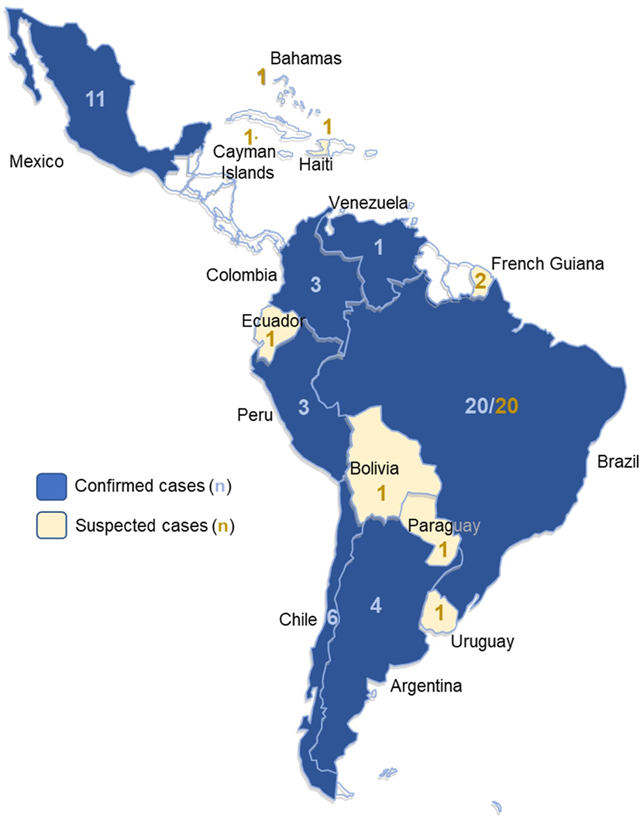
Figure 1- Current situation of MPX in Latin America (confirmed and suspected cases), up to June 28, 2022.
Data sources: https://www.ilpandacentrostudio.it/uk.html, https://www.cdc.gov/poxvirus/monkeypox/response/2022/world-map.html.
On a more positive note, as a consequence of the COVID-19 pandemic, several countries have …
… ramped up their current molecular testing capacity and have established broad laboratory networks sharing genomic surveillance data, resulting in better preparedness against other emerging threats such as the current MPX multi-country outbreak.
Therefore, in addition to those countries throughout the region which have already confirmed cases, many others are also assessing suspected and probable cases through nucleic acid amplification tests (NAATs).
Improvement in data integration between different sectors in the society, including healthcare and public health authorities, enhanced sanitary infrastructure, use of drugs with proven efficacy and safety, as well as the issuing of evidence-based guidelines in multiple countries has prevented a larger-scale expansion of the disease.
Although it is expected that most cases of MPX will present as a mild disease, the last two and half years of the COVID-19 pandemic have positively impacted the quality of primary care interventions, build-up of intensive care units (ICU) capacities, equipment provisions and personnel training, among other advances. 3
One of the great challenges and lessons learned from the pandemic relates to failures in risk communication.
In this sense, strengthening epidemiological surveillance systems, and disseminating adequate information through reliable channels (official social media and web pages) with clear and assertive messages could contribute to gaining greater confidence from the broad public and assisting in the early case detection, thus halting transmission chains and preventing further outbreaks.
Public health professionals, physician communities and organizations, healthcare authorities and scientific experts should combat misinformation and disinformation proactively based on clear, direct, culturally responsive messaging that is free of unnecessary scientific jargon. 4
Despite the significant advances achieved as a consequence of the pandemic, the Latin American region still faces a complex scenario with multiple unfolding syndemics’, …
… including communicable diseases, such as HIV infection, malaria, tuberculosis, orthohantavirus, arboviral diseases (particularly dengue, Zika, chikungunya, and yellow fever), 5 among other endemic diseases.
The still-prevalent large pockets of poverty present in the region are part of an unavoidable context that influences disease emergence having a higher impact in Latin America when compared to other high-income countries.
More recently, this region has also witnessed the re-emergence of some vaccine-preventable diseases, such as chickenpox, a top differential diagnosis when assessing a suspected case of MPX.
Thus, vaccination programs need to be enhanced in order to recover optimal coverage. In the context of the current preparedness, there is an urgent need for healthcare workers’ education on the many clinical and epidemiological aspects of MPX, including considerations about its characterization and inclusion as a part of the differential diagnoses with other endemic diseases that may overlap with similar clinical findings, 6 and even result in co-infections including other sexually transmitted pathogens 7 like Treponema pallidum as well as other causative agents of endemic trepanomatosis like yaws (T. pallidum subsp. pertenue) and pinta (T. carateum) also known to be prevalent in Latin America. 8
A major global concern among research and public health personnel relates to the risk and implications of the potential zoonotic transmission of MPX outside its endemic niche in several African countries.
Can we have endemicity and animal hosts that may sustain further transmission cycles outside Africa? Some likely hosts, such as Didelphis marsupialis, Monodelphis domestica (opossums), Sus scrofa domestica (domestic pig), among others, have proved susceptible and are present in Latin America.
These aspects of potential spillover to other susceptible species in the Americas deserve careful consideration and close monitoring. 9
Several clinical, virological, and immunological aspects also deserve urgent research, mainly because, although the disease was discovered in humans in 1970, there is a significant knowledge gap as evidenced by recent bibliometric studies.
Despite its still moderate risk for expansion, allocation of necessary resources, strengthening epidemiological surveillance systems, and increased capacity building should be promptly prioritized in Latin American countries to detect imported cases and limit onward transmission (including autochthonous cases), which is expected to occur after the arrival imported cases.
Latin America, fortunately, is now more prepared to confront new epidemic threats, as in the case of MPX. 10
Despite its still moderate risk for expansion, allocation of necessary resources, strengthening epidemiological surveillance systems, and increased capacity building should be promptly prioritized in Latin American countries to detect imported cases and limit onward transmission (including autochthonous cases), which is expected to occur after the arrival imported cases.
Latin America, fortunately, is now more prepared to confront new epidemic threats, as in the case of MPX
About the authors & affiliations
Alfonso J. Rodriguez-Morales,a,b,c
* Gustavo Lopardo,d Sergio Verbanaz,e Tomas Orduna,d,f
Susana Lloveras,d,f
Jose María Azenas-Burgoa, ~ g Juan Pablo Escalera-Antezana,h Lucia Elena Alvarado-Arnez,i
Alexandre Naime Barbosa,j
Fredi Diaz-Quijano,k
Sergio Cimerman,l
Tania do Socorro Souza Chaves, ^ m Andrea G. Rodriguez-Morales,n Cecilia Perret,o
Claudio A. Mendez,p Jorge A. Riera,q D. Katterine Bonilla-Aldana,a German Camacho-Moreno,r
Henry Mendoza,s
Ivan Arturo Rodriguez-Sabogal,t
Jose Onate, ~ u Angel A. Escobedo,v Monica Thormann,w Yori Roque,x Patricia Gabriela Zambrano,y
Yenddy Carrero,z Nancy Sandoval,aa Lysien Zambrano,ab Carlos Franco-Paredes,ac Enrique Chacon-Cruz,ad Ivan Lopez-Delgado, ad
Cesar Cuadra-Sanchez, ae Monica Pachar-Flores,af Ricardo Correa,ag Hernan D. Rodriguez-Enciso,ah Veronica Rotela-Fisch,ai
Julio Maquera-Afaray,aj Percy Herrera-Anazco, ~ ak Vicente Benites-Zapata,al Eduardo Savio-Larriera,am Juan David Ramírez,an,ao
Alberto Paniz-Mondolfi,
am,ap Alejandro Risquez,aq David A. Forero-Pena, ~ aq,ar Jaime R. Torres,as and Jose Antonio Suarez at
a
Grupo de Investigacion Biomedicina, Faculty of Medicine, Fundaci on Universitaria Aut onoma de las Am ericas, Pereira,
Risaralda, Colombia
b
Master of Clinical Epidemiology and Biostatistics, Universidad Científica del Sur, Lima, Peru c
Latin American network of MOnkeypox VIrus research (LAMOVI), Pereira, Risaralda, Colombia
d
Catedra de Enfermedades Infecciosas, University of Buenos Aires, Buenos Aires, Argentina e
Servicio de Infectología, Hospital Britanico de Buenos Aires. Buenos Aires, Argentina f
Hospital de Enfermedades Infecciosas F. J. Muniz, Buenos Aires, Argentina ~ g
Hospital Clínico Viedma, Cochabamba, Bolivia
h
Direction, Centros de Salud de Primer Nivel, Secretaría de Salud, Gobierno Autonomo Municipal de Cochabamba,
Cochabamba, Bolivia
i
National Research Coordination, Franz Tamayo University (UNIFRANZ), La Paz, Bolivia
j
Infectious Diseases Department, Botucatu Medical School, UNESP; Brazilian Society for Infectious Diseases, Sao Paulo, SP,
Brazil
k
Departamento de Epidemiologia, Faculdade de Saude P ublica da Universidade de S ~ao Paulo, S~ao Paulo, SP, Brazil. Beneficiary of a fellowship for research productivity from the National Council for Scientific and Technological Development –
CNPq, process/contract identification: 312656/2019–0, Brazil l
Institute of Infectious Diseases Emilio Ribas, S~ao Paulo, Brazil mEvandro Chagas Institute, Health of Ministry of Brazil, Belem, Para, Brazil; Faculdade de Medicina da Universidade Federal
do Para, Brazil
n
Unidad Procedimientos, Policlínico Neurología, Centro de Referencia de Salud Dr. Salvador Allende Gossens, Santiago de
Chile, Chile
o
Department of Pediatric Infectious Diseases and Immunology, School of Medicine, Pontificia Universidad Catolica de Chile,
Santiago de Chile, Chile
p
Instituto de Salud Publica, Facultad de Medicina, Universidad Austral de Chile, Valdivia, Chile q
Hospital de San Fernando, Ministerio de Salud, San Fernando, VI Region, Chile
r
Department of Pediatrics, Universidad Nacional de Colombia, Bogota, DC, Colombia. Division of Infectious Diseases, HOMI,
Hospital Pediatrico La Misericordia, Bogota, DC, Colombia s
Hemera Unidad de Infectología IPS SAS, Bogota, Colombia
t
Hospital San Vicente Fundacion, Rionegro, Antioquia, Colombia u
Clinica Imbanaco Grupo Quironsalud, Cali, Colombia. Universidad Santiago de Cali, Cali, Colombia. Clinica de Occidente,
Cali, Colombia. Clinica Sebastian de Belalcazar, Valle del Cauca, Colombia v
Epidemiology Unit, National Institute of Gastroenterology, La Habana, Cuba
wHospital Salvador Bienvenido Gautier, Santo Domingo, Dominican Republic
x
Pontificia Universidad Catolica Madre y Maestra (PUCMM), Santiago, Dominican Republic y
School of Medicine of the International University of Ecuador, Quito, Ecuador
z
Universidad Tecnica de Ambato, Ambato, Ecuador aaHospital Roosevelt, Guatemala City, Guatemala
References and additional information
See original publication
https://www.thelancet.com/journals/lanam/article/PIIS2667-193X(22)00135-1/fulltext




